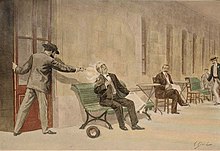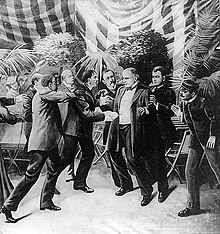User:Kakurokuna/Regicides
Regicides and other assassinations
[edit]This section needs expansion. You can help by adding to it. |
Numerous heads of state and heads of government were assassinated between 1881 and 1914. Regicides were for obvious reasons celebrated as popular victory over counter-revolutionary forces, which remained strong a century after the 1789 French Revolution. The first assassinations were carried out by Russian anarchists, which would lead to the creation of the term of "nihilism". For example, U.S. President McKinley's assassin Leon Czolgosz claimed to have been influenced by anarchist and feminist Emma Goldman. Bombings were associated in the media with anarchists because international terrorism arose during this time period with the widespread distribution of dynamite.[citation needed] The image remains to this day. This perception was enhanced by events such as the 1886 Haymarket Riot, where anarchists were blamed for throwing a bomb at police who came to break up a public meeting in Chicago, Illinois.
Timeline of historical actions
[edit]
- April 4, 1866 – Dmitry Karakozov makes an unsuccessful attempt on the life of Tsar Alexander II.
- May 11, 1878 – Max Hödel makes a failed attempt to assassinate Kaiser Wilhelm I of Germany.
- August 4, 1878 – Sergey Stepnyak-Kravchinsky stabs to death General Nikolai Mezentsov, head of the Tsar's secret police, in response to the execution of Ivan Kovalsky.[clarification needed]
- November 17, 1878 – Giovanni Passannante attempts to assassinate King Umberto I of Italy with a dagger.
- February 1879 – Grigori Goldenberg shoots Prince Dmitri Kropotkin, the Governor of Kharkov in the Russian Empire, to death.
- April 20, 1879 – Alexander Soloviev attempts to assassinate Tsar Alexander II of Russia, failing.
- February 17, 1880 – Stepan Khalturin successfully blows up part of the Winter Palace in an attempt to assassinate Tsar Alexander II. Although the Tsar escapes unharmed, eight soldiers are killed and 45 wounded.
- March 1 (Julian calendar) 1881 – Alexander II is killed in a bomb blast by Narodnaya Volya.
- July 23, 1892 – Alexander Berkman tries to kill American industrialist Henry Clay Frick in retaliation for Frick's hiring of Pinkerton detectives to break up the Homestead Strike, which resulted in the deaths of seven steelworkers. Although badly wounded, Frick survives.

- November 7, 1893 – The Spanish anarchist Santiago Salvador throws two Orsini bombs into the orchestra pit of the Liceu Theater in Barcelona during the second act of the opera Guillaume Tell, killing some twenty people and injuring scores of others.
- December 9, 1893 – Auguste Vaillant throws a nail bomb in the French National Assembly, killing nobody and injuring one, in retaliation against the execution of Ravachol, who was executed for four bombings.
- February 12, 1894 – Émile Henry, intending to avenge Vaillant, sets off a bomb in Café Terminus (a café near the Gare Saint-Lazare train station in Paris), killing one and injuring twenty. During his trial, he declares, "There is no innocent bourgeois."
- June 24, 1894 – Italian anarchist Sante Geronimo Caserio, seeking revenge for both Vaillant and Henry, stabs Sadi Carnot, the President of France, to death.
- November 3, 1896 – In the Greek city of Patras, Dimitris Matsalis, an anarchist shoemaker, attacks banker Dionysios Fragkopoulos and merchant Andreas Kollas with a knife. Fragkopoulos is killed on the spot; Kollas is seriously wounded.
- April 22, 1897 – Pietro Acciarito tries to stab King Umberto of Italy.
- August 8, 1897 – Michele Angiolillo shoots dead Spanish Prime Minister Antonio Cánovas del Castillo at a thermal bath resort, seeking vengeance for the imprisonment and torture of alleged revolutionaries at the Montjuïc fortress.

- September 10, 1898 – Luigi Lucheni stabs to death Empress Elisabeth, the consort of Emperor Franz Joseph I of Austria-Hungary, with a needle file in Geneva, Switzerland.
- July 29, 1900 – Gaetano Bresci shoots dead King Umberto, in revenge for the Bava-Beccaris massacre in Milan.
- September 6, 1901 – Leon Czolgosz shoots U.S. President William McKinley at point-blank range at the Pan-American Exposition in Buffalo, New York, who later dies. Czolgosz's anarchist views have been debated.[citation needed]
- November 15, 1902 – Gennaro Rubino attempts to murder King Leopold II of Belgium as he returns in a procession from a memorial service for his recently deceased wife, Marie Henriette.
- May 31, 1906 – Catalan anarchist Mateu Morral tries to kill King Alfonso XIII of Spain and Princess Victoria Eugenie of Battenberg after their wedding by throwing a bomb into the wedding procession following the ceremony.
- February 1, 1908 – Manuel Buíça and Alfredo Costa shoot to death King Carlos I of Portugal and his son, Crown Prince Luis Filipe, respectively, in the Lisbon Regicide.

- March 28, 1908 – Anarchist Selig Cohen aka Selig Silverstein throws a bomb in New York City's Union Square, which explodes prematurely, killing him and a bystander.
- November 14, 1909 – Argentine anarchist militant Simón Radowitzky assassinates Buenos Aires chief of police, Lieutenant Ramón Falcón by a throwing a bomb at his carriage while Falcón was returning from a deceased fellow officer's funeral.
- September 14, 1911 – Dmitri Bogrov shoots Russian prime minister Pyotr Stolypin at the Kiev Opera House in the presence of Tsar Nicholas II and two of his daughters, Grand Duchesses Olga and Tatiana. Stolypin dies four days later.
- November 12, 1912 – Anarchist Manuel Pardiñas shoots Spanish Prime Minister José Canalejas dead in front of a Madrid bookstore, immediately turning the gun on himself and committing suicide.
- March 18, 1913 – Alexandros Schinas shoots dead King George I of Greece while the monarch is on a walk near the White Tower of Thessaloniki.
- July 4, 1914 - A bomb being prepared for use at John D. Rockefeller's home at Tarrytown, New York explodes prematurely, killing three anarchists, Arthur Caron, Carl Hansen and Charles Berg,[1] and an innocent woman, Mary Chavez[2]
- October 13 and November 14, 1914 – Galleanists – radical followers of Luigi Galleani – explode two bombs in New York City after police forcibly disperse a protest by anarchists and communists at John D. Rockefeller's home in Tarrytown.[1]
- In 1914, Marie Ganz threatens to shoot John D. Rockefeller as she arrives with a crowd and a loaded pistol in front of the Standard Oil Building in Manhattan. He is not in.
- July 22, 1916 – San Francisco Preparedness Day Bombing. 10 persons killed, 40 injured.
- November 24, 1917 9 policemen and a bystander in Milwaukee, Wisconsin killed when a time bomb left at a Catholic church by Galleanists was taken to a police station, where it exploded.[3]

- April 28 – Mayor Ole Hanson of Seattle, Washington, receives a Galleanist mail bomb (defused).
- April 29 – A Galleanist mail bomb intended for U.S. Senator Thomas W. Hardwick explodes, burning a servant and blowing off her hands.
- June 2 – Galleanist Carlo Valdinoci killed when his bomb (intended for the Washington DC home of U.S. Attorney General A. Mitchell Palmer) explodes prematurely.
- June 3 – New York City night watchman William Boehner killed by a Galleanist bomb placed at a judge's house.
- September 16, 1920. – The Wall Street bombing kills 38 and wounds 400 in the Manhattan Financial District. Galleanists are believed responsible, particularly Mario Buda, the group's principal bombmaker, although the crime remains officially unsolved.
- March 8, 1921. – Three anarchists on a motorcycle shoot dead Spanish Prime Minister Eduardo Dato Iradier in Puerta de Alcalá, Madrid.
- 1922. Gustave Bouvet attempts to kill French president Alexandre Millerand.
- May 25, 1926. – Sholom Schwartzbard assassinates Symon Petliura, head of the government-in-exile Ukrainian People's Republic, in Paris.
- October 31, 1926. – Anteo Zamboni, a 15-year-old anarchist, tries to assassinate Benito Mussolini in Bologna by shooting at him during the parade celebrating the March on Rome.
- 1926–1928. Several bombings in Argentina organized by the Italian anarchist Severino Di Giovanni, in the frame of the international campaign supporting Sacco and Vanzetti and against Fascist Italy's interests in Argentina. Bombings of the US embassy, of the Buenos Aires offices of City Bank of New York and Bank of Boston, and of the Italian consulate on May 23, 1928.
- September 27, 1932. A dynamite-filled package bomb left by Galleanists destroys Judge Webster Thayer's home in Worcester, Massachusetts, injuring his wife and a housekeeper.[4][5] Judge Thayer had presided over the trials of Galleanists Sacco and Vanzetti.[6]
- ^ a b Morgan, Ted, Reds: McCarthyism in Twentieth-Century America, New York: Random House, ISBN 0-679-44399-1, ISBN 978-0-679-44399-5 (2003), p. 58
- ^ New York Tribune July 5, 1914
- ^ ODMP memorial
- ^ New York Times: "Bomb Menaces Life of Sacco Case Judge," September 27, 1932, accessed Dec. 20, 2009
- ^ Cannistraro, Philip V., and Meyer, Gerald, eds., The Lost World of Italian-American Radicalism: Politics, Labor, and Culture, Westport, CT: Praeger Publishers, ISBN 0-275-97891-5 (2003) p. 168
- ^ Avrich, Paul, Sacco and Vanzetti: The Anarchist Background, Princeton University Press (1991), pp. 58–60
